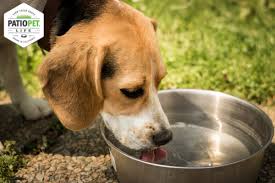It is crucial for us to understand our furry friends’ basic needs and how to properly care for them. This includes knowing the answer to important questions like, “How long can a dog go without water?”
While we may not always be able to provide our dogs with constant access to water, it is important to be aware of the risks and consequences of dehydration.
The importance of water for dogs
Water is essential for dogs for several reasons. First and foremost, water helps to maintain their body temperature and prevent overheating. Just like humans, dogs regulate their body temperature through panting and sweating through their paws.
Without enough water, dogs can quickly become dehydrated, leading to heatstroke and other serious health complications. Additionally, water plays a vital role in digestion and nutrient absorption. It helps to break down food, lubricate the joints, and flush out waste products.
Dogs also lose water through various bodily functions, such as urination and drooling. Therefore, it is important to always provide fresh and clean water for your furry friend to ensure their overall well-being and optimal health.
Factors
While it is clear that water is essential for a dog’s overall health, the amount of water they require can vary depending on several factors. One such factor is the size and breed of the dog. Larger breeds generally require more water due to their larger body size and higher activity levels.
Another factor to consider is the age of the dog. Puppies and senior dogs have different water needs compared to adult dogs. Puppies, who are growing rapidly, require more water to support their development.
Lastly, a dog’s health and medical conditions can affect their water intake. Dogs with certain health conditions like kidney disease or diabetes may require increased or decreased water intake, respectively.
How long can a dog go without water?
Water is vital for all living beings, including dogs. While the exact duration a dog can go without water depends on various factors, it is generally recommended that dogs have access to fresh water at all times.
In ideal conditions, a healthy adult dog can typically survive for about three to five days without water. However, it is important to note that individual dogs may have different tolerances, and their health and environmental factors can greatly influence this timeframe.
It is crucial to be proactive in ensuring your dog’s water intake is sufficient. Dehydration can lead to serious health issues, including kidney damage and organ failure. Therefore, it is best to monitor your dog’s water consumption and provide fresh water regularly to keep them hydrated and healthy.
Signs of dehydration in dogs
As responsible pet owners, it is essential to be aware of the signs that indicate your dog may be dehydrated. By recognizing these signs early on, you can take prompt action to prevent further complications.
Here are some common signs of dehydration in dogs:
1. Dry nose and gums:
One of the first signs of dehydration is a dry nose and gums. When a dog is dehydrated, their nose becomes dry and sticky, and their gums may appear pale or sticky as well.
2. Lethargy and weakness:
Dehydration can sap your dog’s energy, making them lethargic and weak. If you notice a sudden lack of enthusiasm or if your dog appears unusually tired, it could be a sign of dehydration.
3. Loss of appetite:
Dehydrated dogs often lose their appetite. If your dog is not eating as usual or shows no interest in their food, it might be a red flag.
4. Sunken eyes:
Dehydration can cause the eyes to appear sunken or dull. If you notice your dog’s eyes looking different than usual, it’s essential to investigate further.
5. Decreased urination:
Reduced water intake can result in less frequent urination. If you notice your dog producing less urine than usual or having difficulty urinating, it could indicate dehydration.
The role of pet owner
As pet owners, it is our responsibility to ensure that our furry friends stay hydrated. Water is essential for their overall health and well-being. Here are some practical tips to encourage your dog to drink more water and prevent dehydration.
1. Provide fresh and clean water:
Make sure your dog always has access to fresh, clean water. Change the water frequently to maintain its freshness.
2. Use a water fountain:
Some dogs are attracted to flowing water. Consider investing in a water fountain designed specifically for pets. The movement of water may entice your dog to drink more.
3. Add flavor to the water:
Some dogs may be more inclined to drink flavored water. You can try adding a small amount of low-sodium broth or a dog-safe flavoring to their water bowl.
4. Offer wet food:
Wet dog food contains higher moisture content than dry kibble and can help keep your dog hydrated. Incorporate wet food into their diet to increase their water intake.
5. Monitor water intake:
Keep an eye on how much water your dog is drinking daily. If you notice a significant decrease in their water consumption, consult your veterinarian.
Conclusion
It is crucial to understand that the amount of time a dog can survive without water depends on various factors. These include age, size, breed, overall health, and environmental conditions.
Generally, a dog can survive for a few days without water, but it is essential to note that dehydration can set in quickly. Dehydration can lead to serious health issues, such as organ failure and heatstroke.
As responsible pet owners, it is our duty to provide our dogs with access to clean and fresh water at all times. Be vigilant in monitoring their water intake and seek veterinary advice if you notice any significant changes in their drinking habits.



